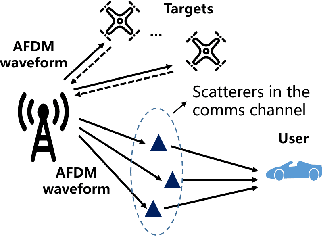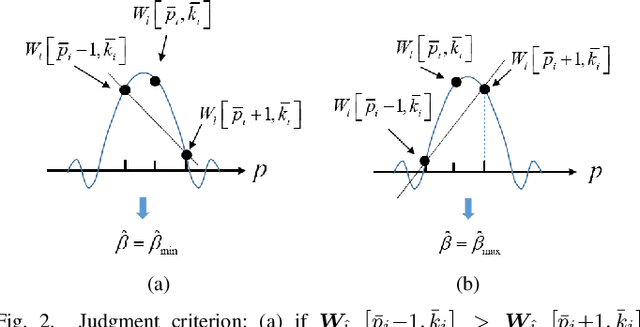Yuanhan Ni
From OFDM to AFDM: Enabling Adaptive Integrated Sensing and Communication in High-Mobility Scenarios
Oct 31, 2025Abstract:Integrated sensing and communication (ISAC) is a key feature of next-generation wireless networks, enabling a wide range of emerging applications such as vehicle-to-everything (V2X) and unmanned aerial vehicles (UAVs), which operate in high-mobility scenarios. Notably, the wireless channels within these applications typically exhibit severe delay and Doppler spreads. The latter causes serious communication performance degradation in the Orthogonal Frequency-Division Multiplexing (OFDM) waveform that is widely adopted in current wireless networks. To address this challenge, the recently proposed Doppler-resilient affine frequency division multiplexing (AFDM) waveform, which uses flexible chirp signals as subcarriers, shows great potential for achieving adaptive ISAC in high-mobility scenarios. This article provides a comprehensive overview of AFDM-ISAC. We begin by presenting the fundamentals of AFDM-ISAC, highlighting its inherent frequency-modulated continuous-wave (FMCW)-like characteristics. Then, we explore its ISAC performance limits by analyzing its diversity order, ambiguity function (AF), and Cramer-Rao Bound (CRB). Finally, we present several effective sensing algorithms and opportunities for AFDM-ISAC, with the aim of sparking new ideas in this emerging field.
A Secure Affine Frequency Division Multiplexing for Wireless Communication Systems
Oct 02, 2025Abstract:Affine frequency division multiplexing (AFDM) has garnered significant attention due to its superior performance in high-mobility scenarios, coupled with multiple waveform parameters that provide greater degrees of freedom for system design. This paper introduces a novel secure affine frequency division multiplexing (SE-AFDM) system, which advances prior designs by dynamically varying an AFDM pre-chirp parameter to enhance physical-layer security. In the SE-AFDM system, the pre-chirp parameter is dynamically generated from a codebook controlled by a long-period pseudo-noise (LPPN) sequence. Instead of applying spreading in the data domain, our parameter-domain spreading approach provides additional security while maintaining reliability and high spectrum efficiency. We also propose a synchronization framework to solve the problem of reliably and rapidly synchronizing the time-varying parameter in fast time-varying channels. The theoretical derivations prove that unsynchronized eavesdroppers cannot eliminate the nonlinear impact of the time-varying parameter and further provide useful guidance for codebook design. Simulation results demonstrate the security advantages of the proposed SE-AFDM system in high-mobility scenarios, while our hardware prototype validates the effectiveness of the proposed synchronization framework.
An Integrated Sensing and Communications System Based on Affine Frequency Division Multiplexing
Jan 31, 2025Abstract:This paper proposes an integrated sensing and communications (ISAC) system based on affine frequency division multiplexing (AFDM) waveform. To this end, a metric set is designed according to not only the maximum tolerable delay/Doppler, but also the weighted spectral efficiency as well as the outage/error probability of sensing and communications. This enables the analytical investigation of the performance trade-offs of AFDM-ISAC system using the derived analytical relation among metrics and AFDM waveform parameters. Moreover, by revealing that delay and the integral/fractional parts of normalized Doppler can be decoupled in the affine Fourier transform-Doppler domain, an efficient estimation method is proposed for our AFDM-ISAC system, whose unambiguous Doppler can break through the limitation of subcarrier spacing. Theoretical analyses and numerical results verify that our proposed AFDM-ISAC system may significantly enlarge unambiguous delay/Doppler while possessing good spectral efficiency and peak-to-sidelobe level ratio in high-mobility scenarios.
An AFDM-Based Integrated Sensing and Communications
Aug 29, 2022



Abstract:This paper considers an affine frequency division multiplexing (AFDM)-based integrated sensing and communications (ISAC) system, where the AFDM waveform is used to simultaneously carry communications information and sense targets. To realize AFDM-based sensing functionality, two parameter estimation methods are designed to process echoes in the time domain and the discrete affine Fourier transform (DAFT) domain, respectively. It allows us to decouple delay and Doppler shift in the fast time axis and can maintain good sensing performance even in large Doppler shift scenarios. Numerical results verify the effectiveness of our proposed AFDM-based system in high mobility scenarios.
 Add to Chrome
Add to Chrome Add to Firefox
Add to Firefox Add to Edge
Add to Edge